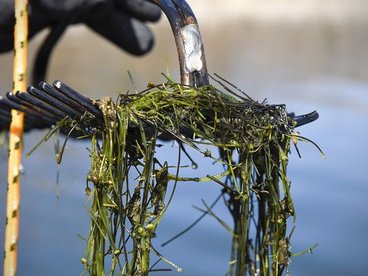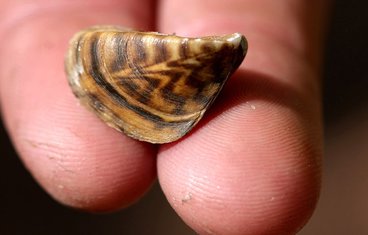
AIS Detectors on Access Minnesota
The AIS Detectors Program at the University of Minnesota is jointly supported by the Minnesota Aquatic Invasive Species Research Center and University of Minnesota Extension, with initial from the Environment and Natural Resources Trust Fund and ongoing support from the state of Minnesota. The Program aims to help protect Minnesota’s life at the lake by empowering community members through its volunteer programs, events, workshops, and other educational offerings. Explore the buttons below to learn more about our programs and offerings.

U of M's Donn Branstrator on spiny waterflea
Donn Branstrator is a professor of biology at the University of Minnesota Duluth and a researcher at the Minnesota Aquatic Invasive Species Research Center. He talks with host CJ Heitoff about spiny waterflea.
Listen here:
https://soundcloud.com/wtip-community-radio/donn-branstrater-on-spiny-water-flea-on-the-roadhouse

Core samples from Mille Lacs Lake may explain walleye woes
Researchers hope to get to the bottom of the challenges that face Mille Lacs Lake walleyes by digging deep into the lake's past.
A group of researchers drilled seven core samples from the lake floor Thursday and Friday afternoon, hoping to look back at least 50 years at what was going on then and now, specifically since the invasive species, spiny waterflea, was discovered there in 2009.
The group of scientists from the Minnesota Aquatic Invasive Species Research Center and University of Minnesota Duluth plan to analyze that 50 years worth of sediment pulled from the lake, after extracting about 200 years worth from the icy depths. Researchers hope to learn more about the role that spiny waterfleas have had in disrupting the food web and contributing to the decrease in walleye numbers.

New U of M Research Lab Works to Stop Aquatic Invasive Species
We've pulled our docks and put our boats away for the winter. Most of us won't give our lakes a second thought; at least until ice fishing begins.
But at the University of Minnesota they will spend the winter working to protect our lakes from invasive species. Five Eyewitness News was the first invited to see a new research lab.

University of Minnesota certifies first class of AIS Detectors
Thirteen residents of Brainerd and elsewhere across northern Minnesota are now the state's first certified detectors for aquatic invasive species in Minnesota lakes.
The AIS Detectors program is a new partnership opportunity developed by University of Minnesota Extension and the Minnesota Aquatic Invasive Species Research Center. It is training citizen scientists to identify numerous aquatic invasive species, including plants such as Eurasian watermilfoil and starry stonewort, invertebrates such as zebra mussels, and fish such as silver carp. Participants are also trained on identifying the native lookalike species that may be found in the same area.

Threat of another AIS
It may have a pretty name and sound more like a fun character from Harry Potter, but a new form of aquatic invasive species is being called ugly and a possible detriment to water recreation.
Starry stonewort, a grass-like form of algae not native to North America, was first confirmed on Lake Koronis near Paynesville in Stearns County in August of last year.

Star(ry) Trek
A year later, the starry stonewort in the net that day on Lake Koronis has made waves across not just Minnesota’s lakes and ponds, but through the network of scientists and advocates who deal with non-native and invasive aquatic species.

Promising Zebra Mussel Treatment In Lake Minnetonka Targets Larvae
As the threat from damaging zebra mussels spreads across Minnesota waters, there’s hope a new control method could bring some relief.
In a first of its kind study, researchers are out on Lake Minnetonka targeting zebra mussel larvae. They’re in one of the more heavily infested parts of the lake in Robinson Bay. That’s where six test enclosures will be treated with a chemical solution to stop the mussels before they form.

Researchers Test New Approach to Control Zebra Mussel Population
Get em’ while they’re young. That’s the new approach researchers are taking to wipe out, or at least control, populations of zebra mussels in lakes across the state.

Researchers target zebra mussel larvae in new study
A study began in Lake Minnetonka this week on a potential new method to effectively manage zebra mussel populations.
During three separate weeks between now and mid-August, low levels of a federally approved copper-based product, EarthTec QZ, are being applied in six enclosures near the shoreline of Lake Minnetonka’s Robinson’s Bay in Deephaven. Following each application, researchers will evaluate the impact of different concentrations of the product on the survival of zebra mussel larvae, called veligers.
Researchers from the Minnehaha Creek Watershed District (MCWD) and the Minnesota Aquatic Invasive Species Research Center (MAISRC) at the University of Minnesota are partnering on the project. Their goal is to decrease the overall zebra mussel population by targeting the invasive species at its earliest stage.
